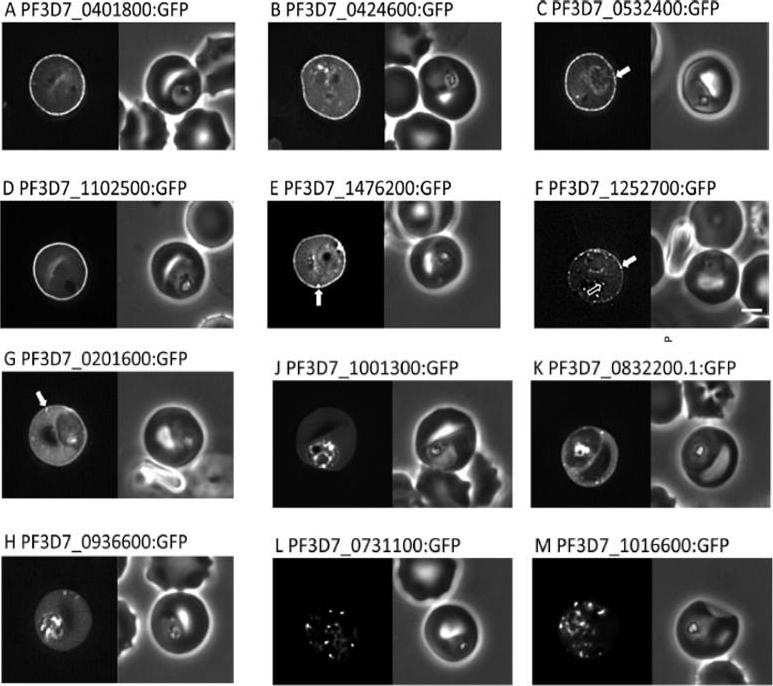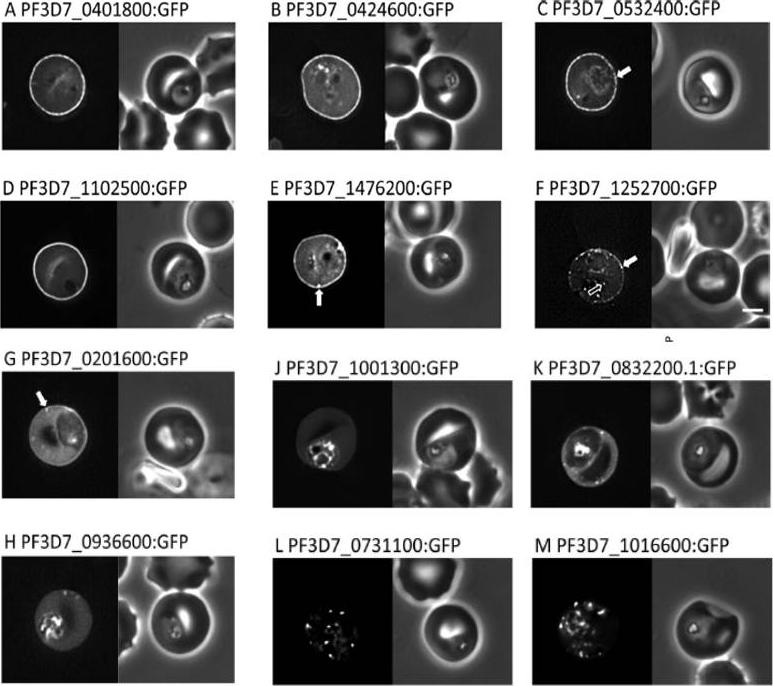PF3D7_1102500 Plasmodium exported protein (PHISTb), unknown function (GEXP02)
Disruptability [+]
| Species | Disruptability | Reference | Submitter |
|---|---|---|---|
| P. falciparum 3D7 |
Possible |
18614010 | Theo Sanderson, Wellcome Trust Sanger Institute |
| P. falciparum 3D7 |
Refractory |
USF piggyBac screen (Insert. mut.) | USF PiggyBac Screen |
| P. falciparum 3D7 |
Possible |
31652487 \"GEXP02 knock-out parasites showed no changes in cell deformability, retained the capacity to exflagellate, infect mosquitoes, and produce viable sporozoites that were able to infect liver cells. Hence, GEXP02 seems to be another dispensable exported protein in P. falciparum, which underpins the point that parasites employ redundant mechanisms for crucial biological processes.\" |
Theo Sanderson, Francis Crick Institute |
Mutant phenotypes [+]
| Species | Stage | Phenotype | Reference | Submitter |
|---|---|---|---|---|
| P. falciparum 3D7 | Asexual |
No difference |
31652487 \"GEXP02 knock-out parasites showed no changes in cell deformability, retained the capacity to exflagellate, infect mosquitoes, and produce viable sporozoites that were able to infect liver cells. Hence, GEXP02 seems to be another dispensable exported protein in P. falciparum, which underpins the point that parasites employ redundant mechanisms for crucial biological processes.\" |
Theo Sanderson, Francis Crick Institute |
| P. falciparum 3D7 | Gametocyte |
No difference |
31652487 \"GEXP02 knock-out parasites showed no changes in cell deformability, retained the capacity to exflagellate, infect mosquitoes, and produce viable sporozoites that were able to infect liver cells. Hence, GEXP02 seems to be another dispensable exported protein in P. falciparum, which underpins the point that parasites employ redundant mechanisms for crucial biological processes.\" |
Theo Sanderson, Francis Crick Institute |
| P. falciparum 3D7 | Ookinete |
No difference |
31652487 \"GEXP02 knock-out parasites showed no changes in cell deformability, retained the capacity to exflagellate, infect mosquitoes, and produce viable sporozoites that were able to infect liver cells. Hence, GEXP02 seems to be another dispensable exported protein in P. falciparum, which underpins the point that parasites employ redundant mechanisms for crucial biological processes.\" |
Theo Sanderson, Francis Crick Institute |
| P. falciparum 3D7 | Oocyst |
No difference |
31652487 \"GEXP02 knock-out parasites showed no changes in cell deformability, retained the capacity to exflagellate, infect mosquitoes, and produce viable sporozoites that were able to infect liver cells. Hence, GEXP02 seems to be another dispensable exported protein in P. falciparum, which underpins the point that parasites employ redundant mechanisms for crucial biological processes.\" |
Theo Sanderson, Francis Crick Institute |
| P. falciparum 3D7 | Sporozoite |
No difference |
31652487 \"GEXP02 knock-out parasites showed no changes in cell deformability, retained the capacity to exflagellate, infect mosquitoes, and produce viable sporozoites that were able to infect liver cells. Hence, GEXP02 seems to be another dispensable exported protein in P. falciparum, which underpins the point that parasites employ redundant mechanisms for crucial biological processes.\" |
Theo Sanderson, Francis Crick Institute |
| P. falciparum 3D7 | Liver |
No difference |
31652487 \"GEXP02 knock-out parasites showed no changes in cell deformability, retained the capacity to exflagellate, infect mosquitoes, and produce viable sporozoites that were able to infect liver cells. Hence, GEXP02 seems to be another dispensable exported protein in P. falciparum, which underpins the point that parasites employ redundant mechanisms for crucial biological processes.\" |
Theo Sanderson, Francis Crick Institute |
Imaging data (from Malaria Metabolic Pathways)

Localisation of PHIST:GFP proteins. The left- and right-hand images show GFP localisation and a phase contrast image, respectively. White filled arrows: peripheral GFP puncta; White unfilled arrow: GFP puncta in host erythocyte cytosol. Scale bar, 2 mm. GFP-tagged PF3D7_0401800, PF3D7_0424600, PF3D7_0532400, PF3D7_1102500 and PF3D7_1476200 were all exported to the host cell and displayed a striking localisation at the edge of the host erythrocyte (1A–E), PF3D7 1252700 was clearly peripheral in the host erythrocyte (F). PF3D7_0201600 (G) shows weak accumulation at the erythrocyte periphery, but the majority of the protein was localised in the RBC cytosol. PF3D7_0936600 was localised in the erythrocyte cytosol, not at the host cell periphery (H).Tarr SJ, Moon RW, Hardege I, Osborne AR. A conserved domain targets exported PHISTb family proteins to the periphery of Plasmodium infected erythrocytes. Mol Biochem Parasitol. 2014 196(1):29-40 PMID: 25106850
See original on MMP
Localisation of PHIST:GFP proteins. The left- and right-hand images show GFP localisation and a phase contrast image, respectively. White filled arrows: peripheral GFP puncta; White unfilled arrow: GFP puncta in host erythocyte cytosol. Scale bar, 2 mm. GFP-tagged PF3D7_0401800, PF3D7_0424600, PF3D7_0532400, PF3D7_1102500 and PF3D7_1476200 were all exported to the host cell and displayed a striking localisation at the edge of the host erythrocyte (1A–E), PF3D7 1252700 was clearly peripheral in the host erythrocyte (F). PF3D7_0201600 (G) shows weak accumulation at the erythrocyte periphery, but the majority of the protein was localised in the RBC cytosol. PF3D7_0936600 was localised in the erythrocyte cytosol, not at the host cell periphery (H).Tarr SJ, Moon RW, Hardege I, Osborne AR. A conserved domain targets exported PHISTb family proteins to the periphery of Plasmodium infected erythrocytes. Mol Biochem Parasitol. 2014 196(1):29-40
See original on MMPMore information
| PlasmoDB | PF3D7_1102500 |
| GeneDB | PF3D7_1102500 |
| Malaria Metabolic Pathways | Localisation images Pathways mapped to |
| Previous ID(s) | PF11_0037 |
| Orthologs | |
| Google Scholar | Search for all mentions of this gene |